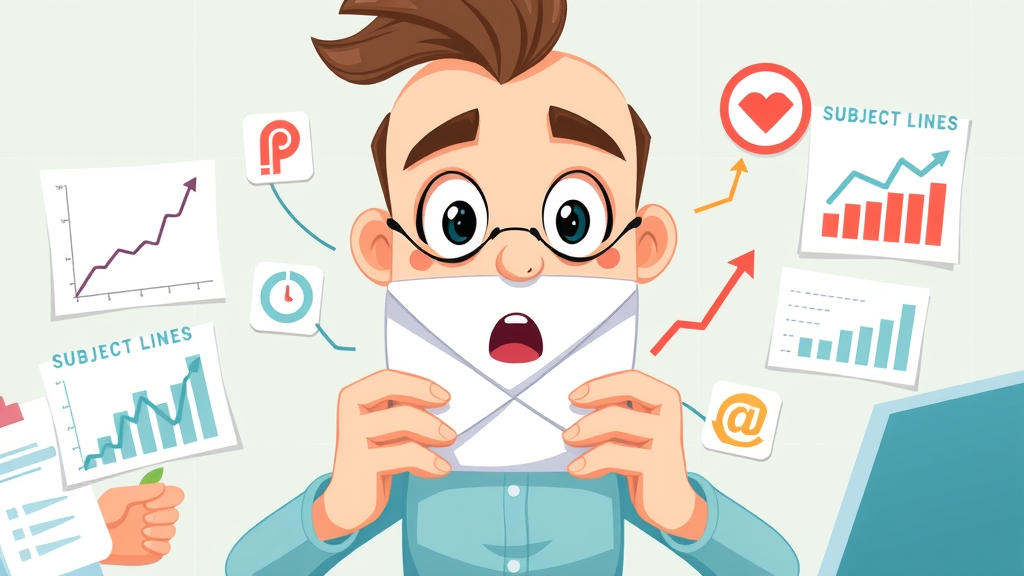Did you know average email open rates for marketing campaigns have dropped by up to 15% in the past year—costing businesses thousands in lost engagement and sales? If you’ve noticed your email open rates slipping, you’re not alone. But the good news is, understanding why open rates drop—and how to fix them—can put your email marketing results back on track fast. Whether you send newsletters, promotions, or nurture sequences, this in-depth guide will help you spot problems and apply proven strategies to boost your metrics.
- Discover why email open rates matter for every email marketing campaign—plus actionable strategies to stop a downward trend.
Unlocking the Secrets Behind Plummeting Email Open Rates: Why It Happens and How to Change Course
When your email open rates take a sudden dip, it can be alarming. After all, the open rate is the first sign your audience is interested in your message. This metric measures how many recipients actually open your emails compared to the total number sent, making it the critical first step in turning subscribers into loyal customers. If users aren’t opening your messages, it means your offers, announcements, or updates are never even seen—impacting your entire email marketing campaign .
Common reasons for dropping email open rates include uninspiring subject lines , poor audience segmentation, and deliverability issues that land your messages in the spam folder. Changes to audience behavior, sending times, and even evolving privacy standards contribute, too. The key is to quickly diagnose the problem areas and take targeted action—before your list engagement drops further. Practical examples, like a well-segmented campaign versus a generic blast, show just how powerful the right tweaks can be for re-engaging subscribers.

Why Email Open Rates are the Core Metric for Email Marketing Success
Understanding Open Rates: What Influences Email Open Rate Metrics
A strong email open rate signals the health of your email marketing strategy . It’s determined by dividing the number of opened emails by the total number delivered, expressed as a percentage. Many factors influence this metric—including subject lines , sender reputation, email list quality, timing, and content relevance. For instance, personalized subject lines spark curiosity, while poorly timed sends or a cluttered email list with unengaged users can drag open rates down. Staying alert to these variables empowers marketers to fine-tune every email campaign for better engagement.
Another critical element is how different industries set expectations for what counts as a good open rate . What’s average for eCommerce may be above—and below—expectations in B2B or nonprofit sectors. Understanding your specific industry’s average helps set achievable goals and tailor strategies that fit your unique list, ensuring continuous improvement in both open rates and eventual email click activity.

The Relationship Between Open Rate, Email Subject Line, and Email Marketing Benchmarks
Email subject lines are often called the “gatekeepers” of your marketing emails. An eye-catching, relevant subject line increases the email open rate dramatically, while a boring or misleading one can send your messages straight into oblivion. Industry marketing benchmarks consistently show that teams focusing on A/B testing their subject lines outperform those who don’t. Leading companies routinely monitor and update these benchmarks to ensure their campaigns resonate with the ever-changing needs of their audiences.
Benchmark studies prove that tweaking a single word, adding a recipient’s name, or even using emojis can boost your average open rate . When combined with relevance and audience targeting, subject lines become a powerful tool not just for higher open rates—but for starting a meaningful conversation with your subscribers. This loop of testing and optimization is at the heart of every high-performing email marketing campaign .
Average Email Open Rate vs. Good Open Rate: Setting Realistic Goals
What’s considered a “good open rate” varies by industry and audience, but most recent marketing benchmarks set the average email open rate between 20% and 35%. If your results hover in this range, you’re within norms; higher numbers mean you’re outperforming the crowd. Knowing your average open rate helps set realistic goals, plan improvements, and pinpoint when something’s amiss. Tracking month-over-month changes, especially after implementing new tactics, keeps you on top of shifting trends and highlights which changes drive the best results for your email campaigns .
"Businesses with high open rates consistently craft compelling subject lines, segment lists, and deliver relevant content—according to the 2024 email marketing benchmark study."
How to Diagnose Dropping Email Open Rates Quickly
Identifying Triggers: What Causes a Sudden Drop in Email Open Rate
Recognizing the causes behind a sudden drop in your email open rate is vital for quick recovery. Major triggers include sending to outdated email lists , lackluster subject lines, sending frequency changes, and a sudden shift in audience preferences. Sometimes, external factors—like new spam filtering rules or changes in email client behavior—affect open rates, too. Monitor your campaigns for patterns: did a specific change precede the decline? Was there a drop after a list import or an update to your segmentation rules?
Dive into campaign-level reporting and monitor trends over time. Comparing historical data—like the last three sends versus the current drop—can reveal if the issue is a one-off or a growing trend. This approach prepares you to troubleshoot issues before they devastate your overall email marketing campaign performance.
Benchmarking Your Current Email Open Rates Against Industry and Marketing Benchmarks
Context is key when evaluating if your email open rate is truly lagging. Benchmark your performance against current marketing benchmarks relevant to your sector. Industry averages for average email open rates are regularly published—use these as a guide to assess your results. Look for the percentage of recipients opening your emails and compare this to your peer set. Are you above, below, or sitting comfortably on the median line?
This benchmarking process allows you to spot outliers and set stretch goals. It also informs what changes are necessary, whether that’s refining your send time, revamping subject lines , or improving your content strategy. Regular assessment against industry norms ensures your campaigns stay competitive and your email open rates remain healthy.
| Industry | Average Open Rate (%) | Good Open Rate (%) |
|---|---|---|
| Retail | 22% | 30%+ |
| B2B | 25% | 35%+ |
| Healthcare | 23% | 33%+ |
| Finance | 20% | 28%+ |
| Nonprofit | 29% | 40%+ |

Analyzing Recent Email Campaign Performance to Find Patterns
To lift sagging open rates , review the performance of your most recent email campaigns . Look for patterns: Which mails performed well? What was their subject line , send time, segmentation, and offer? Were there differences in device or client environments? Evaluate not only opens but also email click rates to ensure engagement continues beyond the first impression.
Use tools that track individual recipient behavior and heatmap analytics to identify successful variants and tactics. Consistent underperformance often means a larger issue with deliverability or email list hygiene—whereas sporadic dips may indicate temporary content or timing misfires. Combining this insight with A/B testing and segmentation refinements ensures every send contributes to a rising average open rate over time.
Best Practices for Improving Email Open Rates Instantly
Crafting the Perfect Email Subject Line for Higher Open Rate
Your email subject line is the single most important factor determining whether an email gets opened or ignored. A compelling, relevant subject line piques curiosity and creates urgency, while a generic or uninspiring one is likely to get lost among dozens of daily messages. Every effective subject line should reflect the content’s value, speak directly to the recipient, and use clear language—a formula that has proven itself in thousands of successful email marketing campaigns .
A/B testing your subject lines is a fast and reliable way to uncover what resonates with your audience. Work in personalization—mention the recipient’s name or tailor the message based on previous purchases or interests. Combining these tactics can yield a higher open rate instantly, especially when you consistently test and refine your approach.

- Personalize every subject line with recipient data
- Keep it short—8-10 words perform best
- Use questions to spark curiosity
- Add urgency or exclusivity without sounding spammy
- Avoid using all caps or excessive exclamation points
- Test emojis—some audiences love them
- Promise clear value (discount, insight, exclusive update)
Segmenting Your Email List for Higher Open Rates
Segmentation separates generic mass emails from high-performing campaigns. Grouping your list based on demographics, behavior, or purchase history allows you to send targeted, relevant content your subscribers actually want to see—raising open rates and reducing unsubscribes or spam complaints. Most modern email marketing platforms build segmentation into their workflow, making it simple to group, test, and continually refine your audience groups.
Effective segmentation also helps you nurture leads, cross-sell products, or re-engage lapsed subscribers with personalized follow-ups. Reviewing segment-level analytics further enables you to optimize future sends, steering your strategy towards ever-higher average email open rates for every marketing campaign.

- Segment by engagement activity (recent openers, clickers, inactive)
- Group by location, age, or purchase behavior
- Tailor content frequency and offers to each segment
- Regularly update segments based on recent subscriber actions
- Set up onboarding, re-engagement, and VIP segments for targeted nurturing
Optimizing Send Time to Maximize Email Open Rate
Send your emails when your audience is most likely to check their inbox. Research shows early mornings and midweek are generally ideal, but every list is unique. A/B test various time slots and analyze your metrics: does your audience respond better at lunch, after work, or on weekends? The right send time can increase email open rates by a considerable margin—sometimes overnight!
Consistency matters, too. Subscribers are more likely to engage if they know when to expect your content, so develop and stick to a regular sending schedule. Monitor real-time analytics to identify unexpectedly high or low performance, and adapt as trends shift or your audience grows and changes.
- Choose three different send times across a week
- Split your list into random, equal segments
- Send identical emails at the chosen times
- Track open rate and email click metrics
- Analyze the winning send time and retest periodically as habits shift
"Sending emails during your audience’s most active hours can boost open rates by up to 35%." — Marketing Benchmark Insights
Improving Email Deliverability as a Foundation for Better Open Rates
All your optimization efforts can fall flat if your emails aren't landing in the inbox. Deliverability depends on list hygiene, sending reputation, authentication (like SPF, DKIM, and DMARC), and engagement metrics. Make sure you're not emailing invalid or disengaged addresses, as high bounce rates or spam complaints alert ISPs and damage your sender reputation. A clean, permission-based list not only lifts email open rates but also protects your brand’s credibility.
Regularly review deliverability metrics and use tools to check for blacklisting or spam-trap hits. Simple practices like personalizing sender names, avoiding common spam triggers, and maintaining a steady sending volume ensure your email marketing campaign reaches as many real inboxes as possible.
Understanding the Impact of Email List Hygiene on Email Open Rates

How a Clean Email List Raises Your Average Email Open Rate
Maintaining a clean list is essential for healthy email open rates . When you routinely remove inactive, bounced, or fake addresses, your open rate percentage increases—because your messages are only being sent to real, engaged subscribers. This process keeps your sender reputation strong, boosting deliverability and ensuring your emails don't land in spam folders.
List hygiene isn’t just a one-time task but an ongoing habit. Use automated tools to regularly purge inactive addresses, run re-engagement campaigns, and ask subscribers to confirm their interest. The result? A leaner, more active list with a much higher open rate for every campaign.
- Validate new sign-ups with confirmation emails
- Monitor bounce rates and remove hard bounces promptly
- Use engagement scoring to prune non-responders
- Send periodic “Still interested?” re-engagement emails
- Automate list cleaning tools based on activity windows
Removing Inactive Subscribers and Managing Bounces to Protect Open Rate
Inactive subscribers can damage your average email open rate by skewing the denominator of your metric. Identify those who haven’t opened or engaged in 3-6 months and either send a win-back sequence or gracefully sunset them from your list. Regularly removing hard and soft bounces—emails that can’t be delivered—reduces spam complaints and protects your deliverability.
A segmented approach works best. Place unengaged users in a separate drip campaign to attempt reactivation before purging them. This ensures you don’t lose potentially valuable contacts while maintaining a focus on quality data and higher open metrics.
Using Double Opt-In to Improve Good Open Rate
Implementing a double opt-in process requires new subscribers to confirm their interest before joining your list. This small extra step ensures only genuinely interested users receive your emails, driving up both your good open rate and long-term engagement. Double opt-in lists tend to show higher engagement, fewer complaints, and healthier sender reputations—resulting in better overall metrics for every email marketing campaign .
Though your list may grow more slowly, the subscribers you gain will be more active, responsive, and likely to convert—turning a strong average email open rate into better results across all marketing KPIs.
The Role of Personalization in Increasing Email Open Rate
Personalized Subject Lines, Dynamic Content, and Higher Open Rates
Adding personalization to your email campaigns—beginning with the subject line —can deliver transformational results. Personalized subject lines, content blocks, and dynamic offers based on user behavior routinely yield higher open rates and more meaningful engagement. When subscribers see their name, interests, or recent activity referenced, they feel understood and valued, making your emails stand out in crowded inboxes.
Advanced personalization goes beyond “Hi [Name],” integrating custom product recommendations, location-based offers, or tailored calls-to-action throughout the message. Marketers leveraging dynamic content report not just better open metrics, but higher downstream conversion, too.

- Add the subscriber’s first name and location in subject lines
- Include dynamic blocks showing recent interactions or purchases
- Use behavioral triggers (like abandoned cart or recent downloads)
- Offer curated recommendations or content based on previous engagement
- Send personalized follow-ups based on individual user journeys
Leverage User Behavior to Segment and Target for Higher Average Email Open
Monitoring subscriber activity allows advanced segmentation. Track opens, clicks, browsing patterns, or purchase frequency, segment your list, and deliver tailored messages accordingly. Users who have interacted with certain products can receive related updates—boosting relevance and open rate . Behavioral segmentation sharpens your targeting, ensuring every campaign is built for maximum engagement, not guesswork.
Start small, tracking key actions and assigning subscribers to relevant sublists. Over time, layering additional data—purchase value, recency, or content interest—produces increasingly powerful results that elevate your average email open rate across every marketing campaign .
"Emails with personalized subject lines generate 50% higher open rates than generic ones." — 2025 Email Marketing Benchmarks Report
Improving Email Campaign Quality to Support High Open Rates
Evaluating Content Relevance to Achieve a Good Open Rate
Relevant content is the engine of every good open rate . Emails that consistently inform, engage, or inspire recipients earn a loyal following and steady engagement. Audit your messages frequently: Are you delivering on the promise made in your subject lines? Do readers get value in every communication? Tightly aligning your content to subscriber interests—gathered from surveys, engagement history, or behavior—keeps open rates strong and fosters ongoing trust.
The format matters as much as the message. Analyze which content types—newsletters, promotions, guides, or re-engagement emails—yield the best open and click results in your audience. Rotate varieties and keep experimenting to uncover hidden opportunities for improved engagement and conversion.
| Email Type | Average Open Rate | Typical Audience |
|---|---|---|
| Welcome Series | 45% | New Subscribers |
| Product Promotions | 22% | All Customers |
| Newsletters | 29% | Prospects & Fans |
| Behavioral Triggers | 38% | Active Users |
| Re-Engagement | 19% | Inactive Subscribers |

Using Consistent Branding and Calls-to-Action to Boost Open Rates
Consistent branding reassures recipients that your emails are trustworthy and worth opening. Use recognizable colors, logos, and sender names in every email. A strong brand presence increases trust and makes it easy for subscribers to spot your mails—even among dozens of daily messages. Well-designed, purposeful calls-to-action (CTAs) both inside the email and previewed in the subject/preview text tell readers exactly what to do next, increasing not only opens but also downstream clicks and conversions.
Regularly review your templates and update CTAs to reflect your current offers and campaigns. Split-testing designs, layouts, and button placements will maximize results and keep content feeling fresh and relevant for repeat readers.

Testing and Optimizing Email Marketing Campaigns Using Metrics Beyond Open Rate
While open rates signal initial interest, the true measure of a successful email marketing campaign goes further. Monitor email click rates, conversions, unsubscribes, and overall list growth for a more complete view. Testing different combinations of content, layout, segmentation, and timing—then tracking the downstream impact—reveals which changes drive the strongest overall performance.
Data-driven optimization is an ongoing cycle. Use A/B and multivariate tests, monitor results, and evolve your approach with every learning. As subscriber preferences shift, so should your approach—ensuring all key engagement metrics, especially open rates , trend upward over time.
People Also Ask: What is a good open rate for email?
Defining a Good Open Rate and Industry Averages in Email Marketing
In most industries, a good open rate averages between 20% and 35%, with top performers regularly exceeding these benchmarks. B2B sectors tend to record higher rates than retail or eCommerce, as do smaller, highly engaged lists. Track your own average open rate against published marketing benchmarks and strive for continuous improvement through segmentation, personalization, and content upgrades.
The most important thing is not to chase a generic standard, but to outperform your own historical performance and build relationships with active, interested readers.
People Also Ask: Is 50% a good email open rate?
How a 50% Email Open Rate Compares to Industry Benchmarks
A 50% open rate is exceptional in nearly every sector and signals a highly engaged audience or an especially successful marketing campaign . Achieving this level often means excellent list hygiene, laser-focused personalization, and content that genuinely delights readers. Compare it to your industry average and use it as a springboard for case studies and sharing best practices across your team.
People Also Ask: Is 30% a good open rate?
Is 30% Above the Average Email Open Rates for 2025?
Yes, a 30% open rate is often above average in 2025, outpacing most sectors’ marketing benchmarks . If you’re consistently achieving this number, your email marketing campaign strategy is resonating with your list. Continue optimizing for content quality and timing to sustain and increase these results.
People Also Ask: What is the industry standard email open rate in 2025?
2025 Email Marketing Benchmarks: The New Industry Standards for Open Rate
According to the latest reports, the 2025 industry standard email open rate sits around 23-28% across most verticals. The benchmarks are slightly higher for nonprofits and B2B, where specialized audiences are the norm. Track these benchmarks but remain focused on continuous improvement through rigorous testing, data-informed segmentation, and content relevance above all else.
Frequently Asked Questions on Email Open Rates and Email Marketing Campaigns
- How often should I clean my email list for optimal open rates? At least quarterly—and immediately after major campaigns or influxes of new subscribers. Regular maintenance prevents deliverability and engagement drops.
- What is the most important factor for increasing email open rates—subject line or timing? Both matter, but subject line usually has a slightly larger impact. Testing both will yield the highest average open rate increases.
- Do industry benchmarks for open rate differ by country? Yes, cultural differences, time zones, and local habits affect all email marketing benchmarks . Custom data is key for international lists.
- Why do some email campaigns get higher open rates than others? The biggest drivers are relevance (content and offer match), list quality, personalization, and how well you time your sends.
Strategies to Maintain Consistently High Email Open Rates Over Time
Building a Long-Term Plan for Optimizing Email Marketing Campaigns
Sustainable email open rates start with solid, ongoing practices. Regularly updating your list, refreshing your content approach, and continually experimenting based on real user data are the backbone of long-term success. Schedule periodic reviews of your segmentation strategy, clean your database proactively, and run re-activation efforts to keep engagement high. Remember, consistency and responsiveness to shifting subscriber behavior will always outperform infrequent or tactical changes.
- Regular list cleaning to remove unengaged addresses
- Frequent content updates and fresh offers
- Reactivation and win-back campaigns for lapsed subscribers
- Data-driven experimentation with timing, segmentation, and messaging
Key Takeaways for Fixing and Sustaining Strong Email Open Rates
- Focus on compelling subject lines and preview text
- Continuously segment your list for relevance
- Keep your email list clean to lift deliverability
- Personalize content for every subscriber journey
- Rely on analytics to drive strategy and spot new trends
Ready to Fix Your Email Open Rates? Elevate Every Email Marketing Campaign Now
- Start implementing these techniques today to increase your open rates and unlock the full potential of your email marketing.
 Add Row
Add Row  Add
Add 




Write A Comment